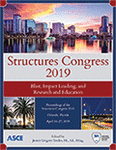Structures Congress 2019
Data-Driven Risk-Based Assessment of Wind-Excited Tall Buildings
Publication: Structures Congress 2019: Blast, Impact Loading, and Research and Education
ABSTRACT
The damage reported from structural and non-structural elements during severe windstorms promoted the extension of the performance-based design (PBD) philosophy to wind-excited tall buildings. A critical part of PBD is the assessing the risk of the facility to extreme wind events. Risk assessment allows the estimation of the probability of failure of the structure considering the uncertainties arising from the external hazard and the structural properties. This paper presents a framework for the risk-based assessment of wind-excited tall buildings using surrogate models. In the proposed framework, the surrogate models are leveraged to reduce the computational burden of time-consuming wind time history analyses. The risk of the building is quantified using the convolution of fragility functions and hazard curves at the site of the building. The surrogate model is constructed using a data-driven approach, where the training data set is derived from a high-fidelity computational model. Then, the surrogate function is used as a representation of the original computational model for risk assessment and future predictions. The proposed procedure is applied to a 39-story building. The building is equipped with motion control devices for wind-induced vibrations mitigation. The wind load is simulated in the time domain as a multivariate stochastic process and numerically applied to the structure. To create the training dataset, the structural response of the building in terms of peak acceleration and inter-story drift is estimated under different wind time histories. Two cases are considered. In the first case, the mean hourly wind speed and the terrain roughness are considered as random variables, while in the second instance the capacity of the damping devices is considered as uncertain. In both cases, the surrogate model parameters are optimized using the maximum likelihood estimation method. Results show that the proposed approach can be used for improving structural resilience under extreme wind events, where the use of surrogate model represents a viable data-driven solution for uncertainty-based risk evaluation.
Get full access to this article
View all available purchase options and get full access to this chapter.
Acknowledgement
This paper is based upon work supported by the National Science Foundation under Grant No. 1537626. Their support is gratefully acknowledged. Any opinions, findings, and conclusions or recommendations expressed in this material are those of the authors and do not necessarily reflect the views of the National Science Foundation.
References
Balesdent, M., Morio, J., & Marzat, J. (2013). Kriging-based adaptive importance sampling algorithms for rare event estimation. Structural Safety.
Ellingwood, B. R., Rosowsky, D. V., Li, Y., & Kim, J. H. (2004). Fragility assessment of light-frame wood construction subjected to wind and earthquake hazards. Journal of Structural Engineering, 1921-1930.
Federal Emergency Management Agency (FEMA). (2012). Seismic performance assessment of buildings, Volume 1 - Methodology. Washington, DC: FEMA Pubblication P-58-1.
Ferrario, E., Pedroni, N., Zio, E., & Lopez-Caballero, F. (2017). Bootstrapped Artificial Neural Networks for the seismic analysis of structural systems. Structural Safety.
Forrester, A., & Keane, A. (2008). Engineering design via surrogate modelling: a practical guide. Engineering design via surrogate modelling: a practical guide.
Gidaris, I., Taflanidis, A. A., & Mavroeidis, G. P. (2015). Kriging metamodeling in seismic risk assessment based on stochastic ground motion models. Earthquake Engineering & Structural Dynamics.
Higham, N.J. (1988). Computing a nearest symmetric positive semidefinite matrix. Linear algebra and its applications.
Mai, C. V., & Sudret, B. (2017). Surrogate models for oscillatory systems using sparse polynomial chaos expansions and stochastic time warping. SIAM/ASA Journal on Uncertainty Quantification.
Mcnamara, R. J., & Taylor, D. P. (2003). Fluid viscous dampers for high-rise buildings.The structural design of tall and special buildings, 145-154.
Micheli, L., Alipour, A., Laflamme, S., Sarkar, P.P. (2019). Performance-based design with life-cycle cost assessment for damping systems integrated in wind excited tall buildings. Engineering structures (under review).
Micheli, L., Alipour, A., Laflamme, S. (2018). Performance-based design for wind-excited tall buildings equipped with high performance control systems. Structures Congress 2018.
Micheli, L., Cao, L., Gong, Y., Cancelli, A., Laflamme, S., & Alipour, A. (2017). Probabilistic performance-based design for high performance control systems. Active and Passive Smart Structures and Integrated Systems 2017.
Mitropoulou, C. C., & Papadrakakis, M. (2011). Developing fragility curves based on neural network IDA predictions. Engineering Structures.
Moehle, J., & Deierlein, G. G. (2004). A framework methodology for performance-based earthquake engineering. 13th world conference on earthquake engineering.
Petrini, F., & Ciampoli, M. (2012). Performance-based wind design of tall buildings. Structure and Infrastructure Engineering.
Seo, D. W., & Caracoglia, L. (2013). Estimating life-cycle monetary losses due to wind hazards: Fragility analysis of long-span bridges. Engineering Structures.
Shinozuka, M., & Deodatis, G. (1991). Simulation of stochastic processes by spectral representation. Applied Mechanics Reviews, 191-204.
Simiu, E., & Scanlan, R. H. (1996). Wind effects on structures.Wiley.
Spence, S. M., & Kareem, A. (2014). Performance-based design and optimization of uncertain wind-excited dynamic building systems. Engineering Structures.
Wang, G. G., & Shan, S. (2007). Review of metamodeling techniques in support of engineering design optimization. Journal of Mechanical design.
Information & Authors
Information
Published In
Structures Congress 2019: Blast, Impact Loading, and Research and Education
Pages: 373 - 384
Editor: James Gregory Soules, McDermott International
ISBN (Online): 978-0-7844-8224-7
Copyright
© 2019 American Society of Civil Engineers.
History
Published online: Apr 22, 2019
Published in print: Apr 22, 2019
Authors
Metrics & Citations
Metrics
Citations
Download citation
If you have the appropriate software installed, you can download article citation data to the citation manager of your choice. Simply select your manager software from the list below and click Download.
